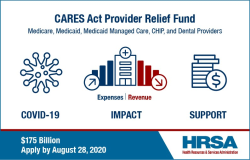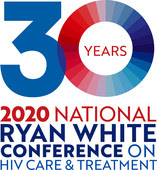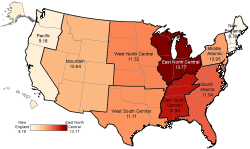
A Message from the Administrator

I’m pleased to announce the release of the HRSA Health Center Program’s 2019 Uniform Data System (UDS) data. Each year, Health Center Program awardees and look-alikes are required to report a core set of information, including data on patient demographics, services provided, clinical indicators, utilization rates, costs, and revenues. The HRSA Data Warehouse provides this data at the national, state/territory, and health center level, as well as summary comparisons and special population program data.
Thank you to the health centers for providing this information every year. Annual performance reporting is vital to achieving HRSA’s mission and understanding the impact of the Health Center Program. More information about UDS, including guidance for 2020 reporting, is available on the HRSA website.
Thank you,
Tom Engels |
HHS Awards over $35 million to Increase Access to High Quality Health Care in Rural Communities

August 20 - Today, the U.S. Department of Health and Human Services (HHS), through the Health Resources and Services Administration (HRSA), awarded over $35 million to more than 50 rural organizations across 33 states as part of a sustained federal effort to increase access to high quality care in rural communities. The awards reflect investments in key areas including telehealth, health workforce training, health research, technical assistance for vulnerable rural hospitals and HIV care and treatment.
“President Trump has made it a priority to strengthen rural health infrastructure and promote the health of rural Americans,” said HHS Deputy Secretary Eric Hargan. “As someone who grew up in rural America and with rural healthcare providers in my family, I know the challenges they face, and I know there’s a need for transformation. These awards are in line with the actions the President called for in his Executive Order on Improving Rural Health and Telehealth Access and are part of our overall effort to improve rural access to care in sustainable and innovative ways.”
|
New Provider Relief Toolkit Available

HRSA’s Provider Support Office has developed a toolkit you can use to reach the large and small practices in your community.
While hundreds of thousands of healthcare professionals who have been impacted in the fight against COVID-19 have received billions of dollars from the federal Provider Relief Fund (PRF), there are still many more who have not yet applied.
Check out our PRF resources and watch our Provider Relief Fund webcast to learn more about the program.
|
Celebrating 30 Years of the Ryan White CARE Act

On Tuesday, HRSA celebrated the 30th anniversary of the Ryan White Comprehensive AIDS Resources Emergency (CARE) Act. In 1990, this critical legislation was signed into law creating the largest Federal program focused uniquely on providing care and treatment to people with HIV – the Ryan White HIV/AIDS Program (RWHAP).
For 30 years, the program has been vital to the public health response to HIV in the U.S. and is a critical component of the Administration’s Ending the HIV Epidemic: A Plan for America initiative.
To honor this milestone, HRSA encourages its recipients, federal partners, and stakeholders to print out and fill in an “I CARE” sign (PDF - 24 KB), take a photo, and share it with @HRSAgov with the hashtag #30YearsofCARE. Access more 30th anniversary resources. Read the HHS Release about this important milestone.
|
2020 National Ryan White Conference Recap

Last week close to 7,500 HIV care and treatment leaders, Ryan White HIV/AIDS Program recipients and providers, and people with HIV participated in HRSA’s virtual 2020 National Ryan White Conference on HIV Care & Treatment. The theme was “30 Years of Innovating Care, Optimizing Public Health, Ending the HIV Epidemic.”
Daily recap blogs from the National Conference are available on HIV.gov. In the following weeks, all National Conference presentations will be made available on TargetHIV.org. To catch up on the virtual National Conference highlights, check out HRSA on Twitter: @HRSAgov.
|
Celebrating 85 Years of Title V Grants for Maternal and Child Health

August 14, 1935 marked 85 years since President Franklin D. Roosevelt signed the Social Security Act, which included Title V—Grants to States for Maternal and Child Welfare. Since then, Title V has formed the foundation of the public health system for mothers, children and families in the United States.
Today, Title V programs touch nearly every U.S. family. In FY 2018, the Title V federal/state partnership served 99% of infants, 91% of pregnant women, and 54% of all children, including children with special health care needs. Over the past eight decades, Title V has contributed to notable improvements in reducing infant mortality and maternal mortality and morbidity, preventing child and adolescent deaths and injuries, and increasing the number of children receiving health assessments and immunizations.
HRSA’s Maternal and Child Health Bureau recognizes the contributions of Title V leaders and MCH partners nationwide and looks forward to continuing to improve the health and well-being of America’s mothers, children and families.
|
New “Catch-up to Get Ahead” Campaign to Promote Childhood Immunizations

In support of National Immunization Awareness Month, HRSA urges health centers and health care providers to “catch-up to get ahead” on childhood immunizations. The COVID-19 pandemic has led to alarming declines in well-child visits and routine immunization rates. This raises the risk for outbreaks and further strain on our nation’s health care system.
To increase childhood immunization rates, HHS is coordinating the “Catch-up to Get Ahead” effort. Promote the importance of childhood immunizations by using social media messages and graphics from the Catch-up to Get Ahead Toolkit.
Find a place to get vaccinated, or find a health center near you.
|
Study Sheds Light on Regional Differences in Infant Mortality Among Black Americans

Infant mortality rates in the USA are highest among Black Americans, yet there are considerable differences between regions of the country. Infant mortality among Blacks is highest in the Midwest and lowest in the West and Northeast. To examine the state and county-level factors that might explain these patterns, researcher Ashley Hirai of MCHB collaborated on a study published in PLOS ONE that was led by Veni Kandasamy, a former HRSA fellow now at John Hopkins University.
The study looked at many factors. When taken together, those factors explained one-third of the regional differences. Factors that “protected” Black infants—or in other words, were associated with lower infant mortality—included: being born in a state with higher levels of Black-White marriage rates (proxy for social integration); being born in a state with higher maternal and child health funding per capita; and, being born in a county with higher levels of Black household income.
To learn more, find the full article in PLOS ONE or contact Ashley Hirai.
|
Rural Health Research Center Finds Continued Declines in Maternity Care in Rural U.S. Counties

A new HRSA-funded University of Minnesota (UMN) study published in the Journal of the American Medical Association (JAMA) finds that rural U.S. counties continue to see declines in hospital-based obstetrics services. Updated data from 2014-2018 shows that an additional 5.7% of rural counties lost obstetric services, on top of the 52.9% of counties that already lacked them.
While UMN pointed to the ongoing trend of losing services as a concern, they also highlighted examples of rural communities successfully supporting births locally. One case study in rural Iowa identified continuity of care and specialized nursing staff as key factors that have enabled their success.
Read the study (PDF - 1.2 MB).
|
Request for Information (RFI) Deadlines Approaching
Maternity Care Health Professional Target Area Criteria

The deadline is approaching to provide public feedback to inform policy considerations related to the establishment of criteria for Maternity Care Health Professional Target Areas (MCTAs), as described in this Request for Information (RFI), and to solicit additional ideas and suggestions from the public related to the RFI’s topic areas. HRSA will accept feedback or suggestions through September 18.
Email responses to RFIComments@hrsa.gov and reference “Maternity Care Health Professional Target Area Criteria RFI” in the subject line.
The requirements of the Public Health Service Act, Section 332(k)(5); (42 USC §254e(k)(5)) define the term “full scope maternity care” as health services provided during labor care, birthing, prenatal care, and postpartum care.
Note: While we welcome input from all stakeholders and parties with an interest in our mission, we specifically seek input from those with knowledge of public health strategies to improve maternal health and maternity care delivery. This includes, but is not limited to: relevant provider organizations; medical societies; organizations representing medical facilities; or other organizations with expertise in maternity care.
|
Health Professional Shortage Areas Scoring Criteria
The deadline is approaching to provide public feedback to inform policy considerations for changes to Health Professional Shortage Areas (HPSA) scoring criteria as described in this Request for Information (RFI). HRSA will accept feedback or suggestions through September 18.
We are also looking for stakeholder input on possible additions or alternative approaches to HPSA scoring. These would include, but are not limited to, new factors, components, or point weighting. We will not accept proposals to expand NHSC eligibility to new provider types or proposals that otherwise go beyond the purview of HPSA scoring.
Email responses to RFIComments@hrsa.gov and reference “Health Professional Shortage Area Scoring Criteria RFI” in the subject line.
Information regarding current scoring is located in a notice published in the Federal Register, 68 Fed. Reg. 32531 (May 30, 2003).
#RuralHealthChat: Preparing Rural Healthcare Systems for COVID-19 Surge

Join us for a Twitter chat Wednesday, August 26, 1 - 2 p.m. EDT to discuss the COVID-19 pandemic's impact on rural health care facilities and learn about strategies to combat a COVID-19 surge in your rural community.
We'll be using the hashtags #RuralHealthChat and #RuralHealthReady to tweet with experts around the country who are excited to share their knowledge.
Learn more and follow @HRSAgov on Twitter.
|
Workshop Webinar: Caring for People with Mental Health and Substance Use Disorders in Primary Care Settings

The National Academies of Science, Engineering and Medicine (NAS) will host the final session of a three part series on Wednesday, August 26, Noon - 3:30 p.m. EDT.
This HRSA-supported webinar will examine approaches to deliver, incentivize and pay for essential components of care for alcohol use, depression care management and opioid use disorder in primary care settings.
Parinda Katri from HRSA grantee Cherokee Health System (Health Center Program) and Colleen LaBelle, Director of the Boston University School of Medicine, Clinical Addiction Research & Education (CARE) Unit will discuss workforce training needs regarding integrated care. This session follows our two webinars in June and July which explored how essential components of care align with evolving models including Accountable Care Organizations, Patient-Centered Medical Homes, and Collaborative Care arrangements.
|
Using Pharmacists to Provide Care in Rural Areas

The National Conference of State Legislatures (NCSL) wrote a blog post highlighting the importance of pharmacists in expanding access to care in rural areas.
The post also provides an overview of the new Pharmacist provider page which provides a state breakdown of scope of practice policy related to pharmacists’ ability to modify prescriptions, prescribe hormonal contraceptives, and prescribe tobacco cessation aids.
The blog post and the website are supported by HRSA through a cooperative agreement with the National Organizations of State and Local Officials (NOSLO).
|





















.png)









No hay comentarios:
Publicar un comentario